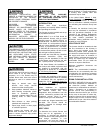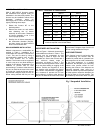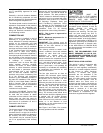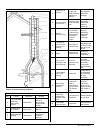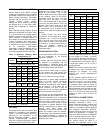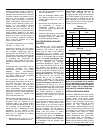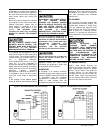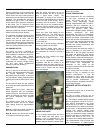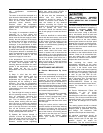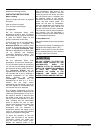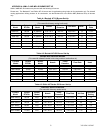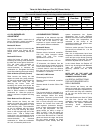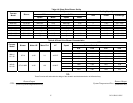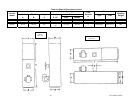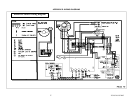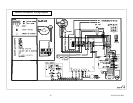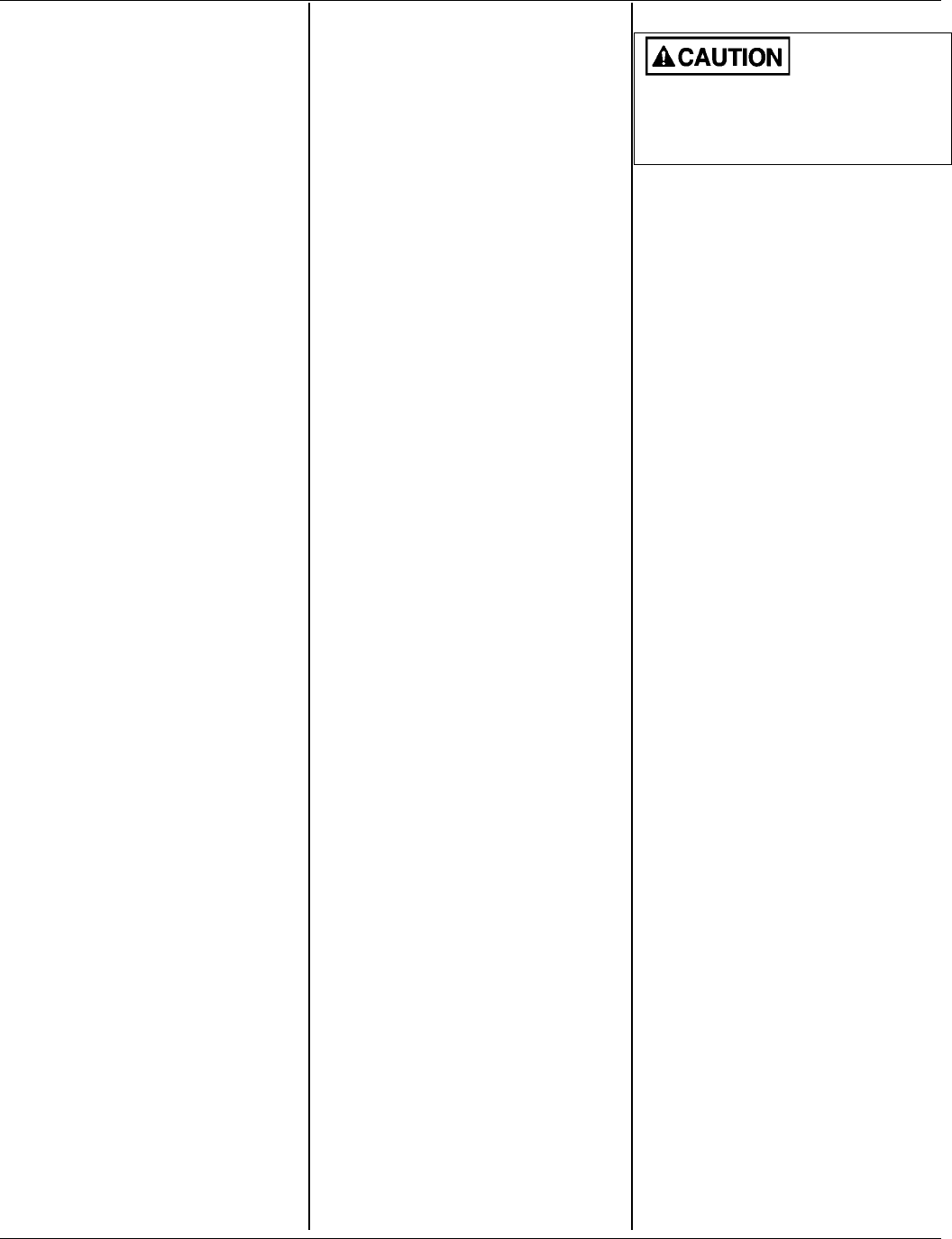
30318 R4 9/9/2005
11
used in conjunction with multi-meters
with temperature measurement
capabilities.
The return air should be measured at a
point where the thermometer will be well
within the air stream near the furnace
return air inlet. Actual location is not
particularly critical; however, avoid
locations where the temperature
readings could be affected by humidifier
bypass ducts, the inside radius of
elbows, etc.
The supply air temperature should be
measured at a point where the
thermometer will be well within the air
stream near the furnace supply air outlet.
Usually, the side mid-point of the supply
air plenum take-off is ideal, providing it is
out of the line of sight to the heat
exchanger. If the thermometer is within
the line of sight of the heat exchanger,
the supply air readings may be skewed
by radiant heat from the heat exchanger.
If the plenum take-off is unsuitable, the
supply air temperature may be measured
within the first 18 inches of the first
segment of supply air trunk duct.
If the temperature rise is outside the
recommended range, it may be adjusted
on direct drive equipped units by
selecting alternate circulation fan motor
speeds. If the temperature rise is too
high, speed the fan up. If the
temperature rise is too low, slow the fan
down.
C) Keep in mind that the stack
temperature varies directly with the
temperature rise. The higher the
temperature rise, the higher the stack
temperature will be, resulting in lower
efficiency. The lower the temperature
rise, the lower the stack temperature will
be, which, in some cases, may allow
condensation to form in the chimney and
other vent parts.
D) Test the high limit control to ensure
that it is operating correctly. This may be
done by temporarily removing the
circulator fan heating wire or neutral
wire. Turn of electrical power to the
furnace before working with the motor
wires. Be sure to protect any removed
wires from shorting out on metal furnace
parts. If the high limit test is successful,
shut off the electrical power to the
furnace, restore the proper motor wiring.
Finally, restore power to the furnace.
E) Operate the furnace through a
minimum of three full heating cycles.
During this time, check for fuel oil leaks,
gross air leakage from the supply air
ductwork, unusual noises originating
anywhere within the heating system
which may cause some concern or
annoyance to the home owner, etc.
F) Be sure that the homeowner is
familiar with the furnace. The
homeowner should be aware of the
location of electrical circuit breaker or
fuse, the location of any electrical
switches controlling the furnace, the
location of the oil tank shut-off valve and
how to operate the valve. The
homeowner should be informed where
the oil tank gauge is located and how to
read it.
It would be beneficial to review safety
issues with the home owner, such as the
danger of storing combustibles too close
to the furnace, hanging anything on the
furnace vent pipe, and especially the
dangers of indiscriminately pressing the
burner reset button.
IMPORTANT: Be sure that the home
owner knows where the burner reset
switch is located, and is aware that the
reset switch is not to be activated more
than once without a thorough look for the
cause of the problem, (lack of fuel, etc.).
Be sure that the homeowner knows
when to quit trying to start the furnace
during these conditions and who to call
for emergency service.
MAINTENANCE AND SERVICE
A: Routine Maintenance By Home
Owner
Other than remembering to arrange for
the annual professional servicing of the
furnace by the service or installation
contractor, the most important routine
service performed by the homeowner is
to maintain the air filter or filters. A dirty
filter can cause the furnace to over-heat,
fail to maintain indoor temperature during
cold weather, increase fuel consumption
and cause component failure.
The furnace filter(s) should be inspected,
cleaned or replaced monthly. The
furnace is factory equipped with a semi-
permanent type filter. If the filter is
damaged, replace with filters of the same
size and type.
During the routine service, inspect the
general condition of the furnace watching
for signs of oil leaks in the vicinity of the
oil burner, soot forming on any external
part of the furnace, soot forming around
the joints in the vent pipe, etc. If any of
these conditions are present, please
advice your service or installation
contractor.
B: Annual Service By Contractor
THE COMBUSTION CHAMBER
(FIREPOT) IS FRAGILE. USE CARE
WHEN INSPECTING AND CLEANING
THIS AREA.
The heat exchanger should be inspected
periodically and cleaned if necessary. If
cleaning is necessary, SHUT OFF
POWER TO THE FURNACE and
remove the burner. Using a stiff brush
with a wire handle, brush off scale and
soot from inside the drum and flue pipe.
To clean the radiator, remove the round
cover or covers on the inner radiator
access pipes located on the front panel
between the oil burner and the flue pipe.
Rear breech models have a single front
cleanout and front breech models have
two front cleanouts.
A wire brush can be used to loosen dirt
and debris on the inside surfaces of the
radiator. Clean out all accumulated dirt,
soot and debris with a wire handled
brush and an industrial vacuum cleaner.
Replace the clean-out covers.
Most circulating fan motors are
permanently lubricated by the motor
manufacturer. These motors will have no
oil ports. If the blower motor does
contain oil ports, under normal operating
conditions it will not require oiling for the
first two years. Oil sparingly; a few drops
in each oil port with SAE 20 non-
detergent oil. Oiling is most easily done
with a "tele-spout" oiler. This oiler has a
long flexible plastic spout. DO NOT
OVER-LUBRICATE. Excess oil may
result in premature electric motor failure.
Inspect the blower fan. Clean it if
necessary.
Oil Burner Maintenance: Follow the
instructions of the oil burner
manufacturer. (See oil burner
manufacturer's instructions supplied with
furnace). The oil burner nozzle should be
replaced annually. We recommend that
the oil filter be changed on an annual
basis.
The venting system should be cleaned
and inspected for signs of deterioration.
Replace pitted or perforated vent pipe
and fittings. The barometric draft
regulator should open and close freely.
All electrical connections should be
checked to ensure tight connections.
Safety controls such as the high limit
controls should be tested for
functionality. The fan control functions



